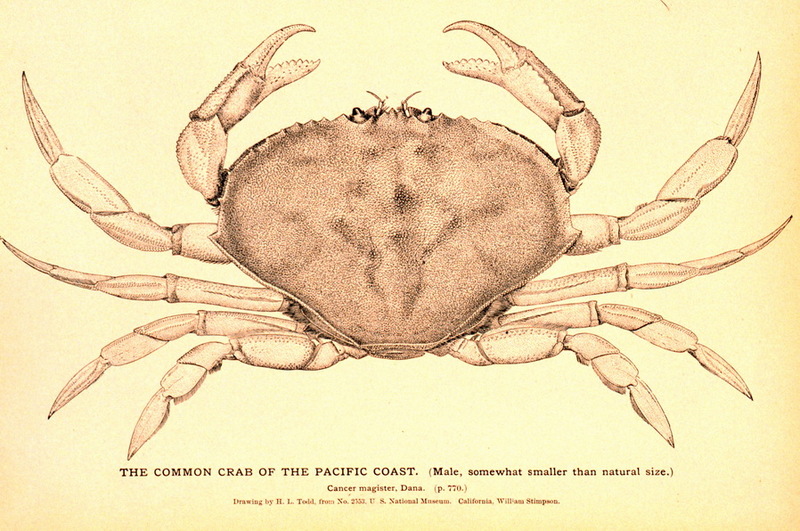Dungeness crab
From Wikipedia, the free encyclopedia
[Photo] Plate 261. The Common Crab of the Pacific Coast. (Male.) Cancer magister, Dana. From "The Fisheries and Fisheries Industries of the United States" by George Brown Goode. Image ID: figb0533, Historic NMFS Collection
The Dungeness crab is a species of crab that inhabits eelgrass beds and water bottoms from the Aleutian Islands in Alaska to Santa Cruz, California. Its binomial name, Cancer magister, simply means "master crab" in Latin.
They measure as much as 25 cm (10 inches) in some areas off the coast of Washington, but typically are under 20 cm (8 inches). They are a popular delicacy, and are the most commercially important crab in the Pacific Northwest, and as far south as Santa Barbara, California.
Dungeness crabs have a wide, hard shell which they must split in order to grow; this process is called ecdysis. They have five pairs of legs, which are similarly armored, the foremost pair of which ends in claws which the crab uses both as defense and to tear apart large food items. The crab uses its smaller appendages to pass the food particles into its mouth. Once inside the crab's stomach, food is further digested by the "gastric mill", a collection of tooth-like structures. Cancer magister prefers to eat clams, other crustaceans and small fish, but is also an effective scavenger. Dungeness crabs can also bury themselves completely in the sand if threatened.
Males are attracted to potential mates by pheromones present in the urine of female Dungeness crabs. Upon locating an available female, the male initiates a protective pre-mating embrace that lasts for several days. In this embrace, the female is tucked underneath the male, oriented such that their abdomens touch and their heads face each other. Mating occurs only after the female has molted, and the female signals her readiness to molt by urinating on or near the antennae of the male. The female extrudes the eggs from her body several months later; however, they remain attached under her abdomen for three to five months until they hatch. Young crabs are free-swimming after hatching and go through five larval stages before reaching maturity after about ten moults or two years.
The safest place to hold the Dungeness crab is its back. Although the hind part of the crab is commonly used to pick up the crab, their claws can sometimes reach the holder's hand.
They are named after Dungeness, Washington, which is located approximately five miles north of Sequim and 15 miles east of Port Angeles. The annual Dungeness Crab and Seafood Festival is held in Port Angeles each October.
Dungeness crab have been found in the Atlantic Ocean, raising concern about their possible effects on the local wildlife.
Cookery
Dungeness crabs can typically be purchased either live or pre-cooked. Larger crabs are valued for the higher meat to shell ratio. Live crabs are cooked simply by steaming for 15???18 min, or boiling for approximately 10 min in water. Beer, crab boil spices, or other flavorings can also be added to the water if desired
Like all crabs, the Dungeness crab is high in protein and minerals and low in fat. About one quarter of this crab's weight is meat, making it one of the meatiest crabs available. Most of the meat is in the eight legs and two claws, although the body contains plenty as well.
The flesh has a delicate flavor and is considered sweeter than other crabs.
The two most useful tools for removing crab meat from the shell are a nutcracker and a shrimp fork. Sometimes, a cleaver, mallet or small hammer are used for cracking. Melted butter with garlic is frequently used as a dipping sauce.
http://en.wikipedia.org/wiki/Dungeness_crab
| The text in this page is based on the copyrighted Wikipedia article shown in above URL. It is used under the GNU Free Documentation License. You may redistribute it, verbatim or modified, providing that you comply with the terms of the GFDL. |
|

